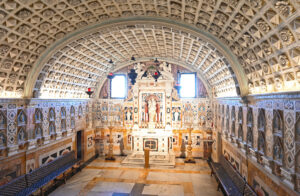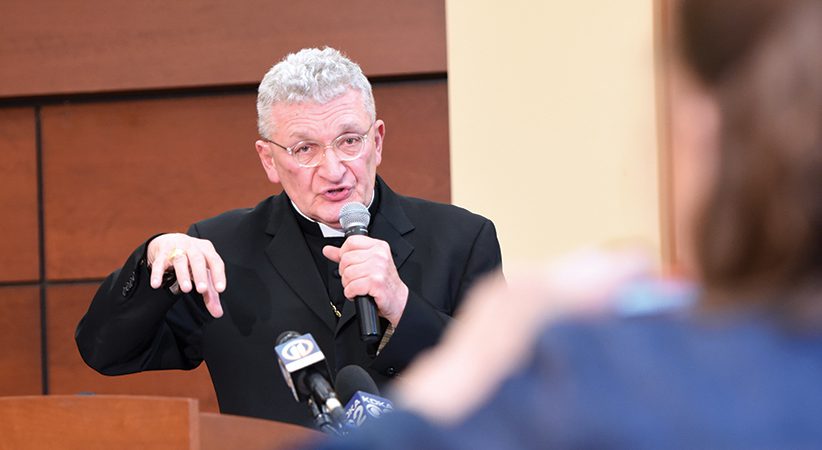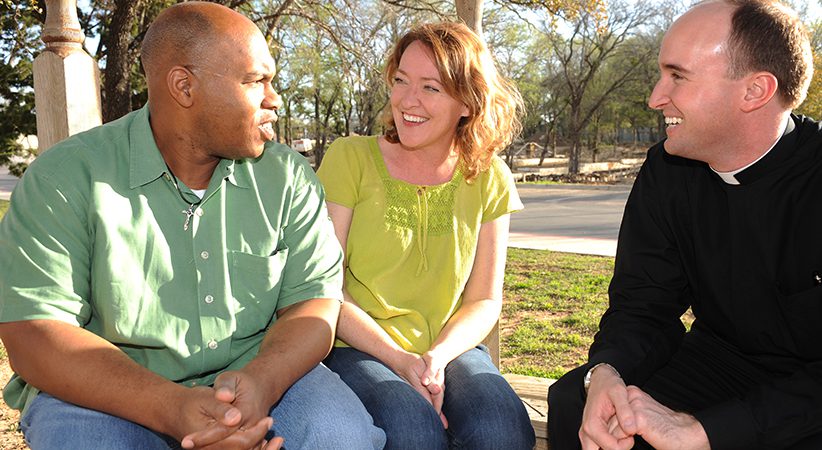Holy Ground
The role of shrines in Catholic tradition
D.D. Emmons Comments Off on Holy Ground
There is a story from the aftermath of World War II about the villagers in a certain German town captured by Allied forces. Residents were concerned about how they would be treated by the occupying Americans, but their fears greatly subsided when they saw two American servicemen praying bareheaded on their knees in the local shrine. The holiness of our sacred Catholic shrines crosses time, place and culture — even war.
Shrines have been part of the Christian faith since the time of Christ; the places of his birth, life, death and resurrection became the first Christian shrines. As Christianity grew, the faithful wanted to visit those holy locations, but they were initially cautious, fearful of certain Jews and especially of the Romans, who were still persecuting Christians. When Emperor Constantine ended religious persecutions in the fourth century, there was a period when these places could be visited, and shrines began to be erected at the sites of events such as the Annunciation, the Nativity and the Resurrection.

When Muslims occupied the Holy Land in later centuries, Christian shrines were often either destroyed or visits to them restricted. These actions, in part, prompted the Crusades of the 11th and 12th centuries, instigated by the popes seeking to take back the Holy Land. When European Christians couldn’t travel to the sites of Christ’s passion, they built local replicas of the shrines, and pilgrims flocked to them. More and more shrines were built at places of martyrdom, spots where a Christian or Christians gave up their lives for Christ.
What Makes a Shrine
In the context of the Catholic Christian faith, shrines are “prominent sacred localities (that) may be the burial place of a saint, or where a heavenly apparition took place … (and) are the focus of pilgrimages by the faithful and often of miraculous phenomena approved by the Church,” according to John A. Harden, SJ, in “Modern Catholic Dictionary.” Canon law adds, shrines are “a church or other sacred place to which numerous members of the faithful make pilgrimage for a special reason of piety, with approval of the local ordinary” (No. 1230).
Depending on the translation, the term “shrine” is rarely found in the Bible, though the Old Testament is filled with stories about altars and “high places” that clearly relate to shrines today. Altars named in the Old Testament were often built on high or elevated areas to be closer to God. The first altar identified in the Bible (Gn 8:20) was built by Noah, erected as thanksgiving and worship to God because he had spared Noah, Noah’s family and the animals from the flood. The Old Testament identifies altars (shrines) built by others such as Abraham, Moses, Elijah, David, Samuel, Isaac — all built on sites where some miracle or encounter with God took place. People came to worship and adore God almighty. The pagans also erected altars to their gods, such as Baal and Asherah; the Scriptures explain how God, through his servants, including Abraham, Moses, Hezekiah, Josiah and Gideon, cut down pagan shrines. The Acts of the Apostles tells of a silversmith who made and sold miniature silver shrines depicting the temple in Ephesus where pagans worshipped the goddess Artemis: “There was a silversmith named Demetrius who made miniature silver shrines of Artemis” (19:24).
For centuries there were few Church criteria for establishing a shrine; in fact, until the 1983 Code of Canon Law, shrines were rarely discussed in official Church documents. Today, diocesan bishops, the council of Catholic bishops in each country and the pope all have roles in establishing a shrine (Code of Canon Law, Nos. 1230-1234). A local shrine is designated by a diocesan bishop; for it to be named a national shrine requires action by the country’s council of bishops; for that shrine to be “upgraded” to an international shrine requires action by the Vatican. The newest national shrine in the United States is Our Lady of Martyrs located in Auriesville, New York. Built in 1884, it was named a national shrine by the U.S. bishops in January 2025. Procedures for designating a national shrine are found in a USCCB document “Norms for the Designation of a National Shrine.” The newest international shrine is the Shrine of Our Lady of Peace and Good Voyage in Antipolo City, Philippines, added to the list in March 2024.

In February 2017, Pope Francis transferred responsibility for shrines from the Vatican Congregation for Clergy to the Pontifical Council for Promoting New Evangelization. Earlier, in August 2011, Cardinal Mauro Piacenza and Cardinal Celso Iruzubieta, from the Congregation for the Clergy, wrote a letter to shrine administrators: “The shrine continues to be, even to our day, a privileged place in which the human person, a pilgrim here on earth, experiences the loving and saving presence of God. He finds there a fruitful space, away from daily distractions, where he can recollect himself, gather his thoughts and reacquire the spiritual health to re-embark upon the journey of faith with greater ardor. It is there too that he can find space to seek, find and love Christ in his ordinary life, in the midst of the world.”
Shrines Around the World
There are 11 international shrines, 230 national shrines and thousands of local shrines in the Roman Catholic world. Eighty percent of all shrines are dedicated to the Blessed Mother. In fact, three of the most visited of all shrines are devoted to Mary: the Basilica of Our Lady of Guadalupe in Mexico City, the Basilica of Our Lady of Aparecida in Brazil and Our Lady of Lourdes in France. The Vatican has approved the apparitions of the Blessed Mother at 16 Marian shrines.
At shrines of Our Lady, we take comfort in knowing she is the ultimate distributor of grace, the ultimate intercessor before Our Lord. Cardinal Timothy Dolan recalls a visit to the shrine of Our Lady of Guadalupe in his book “Called to Be Holy” (OSV, 1997). He was intrigued by the evidence indicating that the eyes of the Blessed Mother’s image reflect the presence of another person, believed to be St. Juan Diego. “The day I went to the shrine was a time of pilgrimage for priests,” Cardinal Dolan writes. “I stood on the platform in front of Mary’s image observing, praying and watching hundreds of priests, old and young, sick and strong, white, brown and black looking into her eyes. And I imagined the reflection of each individual person in the eyes of the virgin, as she looks at each of us, as she did Jesus and Juan Diego. She helps us discover, deepen and persevere in our identity, our vocation and our mission.” Transformation, renewal, reawakening can result from visits to a shrine.
Shrines range in size from huge basilicas to small grottoes. Millions of Catholic pilgrims travel to these holy sites year after year. At some shrines, the traditional Latin Mass is celebrated. The faithful may attain a plenary indulgence when they visit a designated shrine and devoutly recite the Our Father and the Creed on the solemnity of its titular, when they assist in a group pilgrimage visiting the shrine, or once a year on a day of their choosing (USCCB Manual of Indulgences, No. 33). All other norms for receiving an indulgence must be satisfied.
For many, the journey to a shrine is a unique experience, especially when the pilgrim interacts with others making the same trek. The takeaway is new friends, new appreciation for the world we live in and for those also seeking God’s presence and peace. Sometimes the experiences of a long arduous journey can become the center of the trip rather than the shrine. Some travelers completing the 500-mile walk on the El Camino de Santiago, from France to Spain, have reported that conquering the difficulty of the journey outweighed their visit to the relics of St. James in the Cathedral of Santiago de Compostela. A traveler arriving at another holy place once said, “the shrine was not a destination but was a good place to stop.” Such is not the mindset of most Catholic pilgrims.

For the Catholic believer, the journey is an experience, but the shrine is the goal. Praying at the site of a saint’s relic or the spot of a martyr’s demise, the place of an apparition of the Queen of Heaven or the location of a miracle, can result in unimagined blessings and grace, as the faithful have reported again and again.
Shrines are places of spiritual renewal and miraculous physical healings. For example, at Lourdes there have been 72 miraculous, Church-confirmed healings over the years. At shrines like the Black Madonna Shrine in Czestochowa, Poland, and others can be found crutches and canes left behind by pilgrims who experienced healing at those places. St. Philomena’s shrine at Mugnano, Italy, has been the site of many reported miraculous healings. In 1835, Blessed Pauline Jaricot, suffering from an incurable heart disease, traveled to the shrine, prayed in the presence of Philomena’s relics, sought her intercession and was cured. Since the early Church, Christians believe in the healing power of a saint’s remains, their clothing, items they used or touched. The Acts of the Apostles tells of the mighty deeds of St. Paul: “So extraordinary were the mighty deeds God accomplished at the hands of Paul that when face cloths or aprons that touched his skin were applied to the sick, their diseases left them and the evil spirits came out of them” (19:11-12).
Rectors, pastors and shrine administrators have an awesome responsibility to the people of God. Encouraging parishioners to visit, even leading them to a shrine, is a noble act by any pastor.
D.D. EMMONS writes from Pennsylvania.





